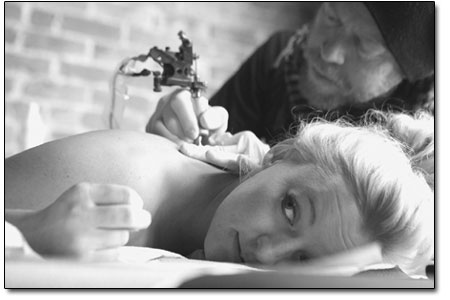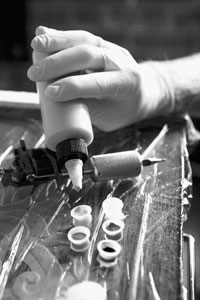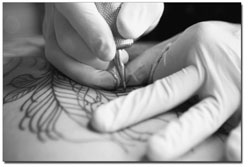|
| ||||||
| Skin deep
by Stew Mosberg Body art used to be a stigmatic emblem on the biceps of tough guys, sailors and carnival sideshow folk. Evidence of body marking has been found as far back as 3,300 BC and is as diverse as the people who wear it. Throughout the ages, indigenous peoples have ceremoniously decorated themselves; in some Africa cultures, body mutilation marks each person as a member of the group, rather than enabling them to stand out as individuals. The word tattoo stems from the Polynesian and Tahitian “ta” and “tatau,” respectively, which in essence means “to mark” something. In the past 20 years, body art has become part of the pop culture. And with its four tattoo shops and a large number of local residents sporting ink, Durango is a mini-Mecca for the medium. One would be hard pressed to meet a 20- or even 30-something who doesn’t possess permanent skin graphics. National acceptance, or at least awareness of the tattoo craze, is even more obvious now that that bastion of female consumerism, Barbie, comes in a body art version. It is so prevalent in fact, that an estimated 40 percent of Americans between the ages of 26 and 40 have been tattooed, and more than a third of Americans 18 to 25 have also been inked. One local body art talent, Roger Seliner, of Your Flesh Tattoo, acknowledged the shift in perception about body art as well as the enhanced talent of tattoo artists. Seliner credited Don Ed Hardy, a California tattoo artist who incorporated Japanese aesthetic and technique into his American style work. In a 2007 magazine interview, Hardy spoke of the new tattoo artists entering the field, “This is now an option for people coming out of art school or people who just have talent.(Customers) know that they can come in and ask for specific images.” Even the appearance of tattoo “parlors” has changed. Your Flesh, for example, spent three months renovating its facility. With its exposed brick walls, museum lighting, a top-notch sound system, and an airy, friendly atmosphere, the salon looks more like a spa than a back alley enterprise. In contrast to the “flash,” which are the typical design offerings displayed on the walls of tattoo shops, Your Flesh is decorated with elaborate, framed graphic images not unlike an avant garde art gallery. Blue Tiger Tattoo, owned by artist Bob Lyon, is smaller than Your Flesh, but is brightly lit and covered wall to wall with “flash.” Lyon, like most seasoned professional tattoo artisans, has his own unique style, and possesses integrity about what he will and won’t do. “I have an old-school mentality,” he said. “I won’t work on faces, necks or hands. I just don’t feel it’s what I want to do.” Asked if he thinks tattooing can become addictive for customers, Lyon quipped, “I don’t think so, at least there’s nothing in the ink that I know of.”
The ink, incidentally, is made from a variety of materials, and some people have found they are allergic to it. Unfortunately, they don’t find out if they have an adverse reaction until well after the art has been permanently embedded. On the other hand, the allergies are rare. Keeping the fresh mark clean and out of the sun is more important, and according Seliner, a lot of exposure to the sun will eventually fade the vibrant colors of a design. In addition, “skin type and tone will definitely play a role in how the color will appear,” he pointed out. The artists themselves are often like walking advertisements for their craft, and as Seliner recounted, “I started out by drawing on myself as a kid.” However, most tattoo artists go to their peers to have art needled into their own bodies. Lyon added, “Most of the people in this business are ethical, the majority far exceeds those that aren’t. Tattooing is not a hobby; it’s my way of life.” Watching the creation of the art is like watching a surgeon at work. It is exacting and takes an incredibly steady hand, and the pros will tell you that two to four hours at a stretch is the maximum amount one can work, or for a client to remain still. Considering the amount of time it takes to have a tattoo done, it raises the question of cost. With the average wage in Durango somewhere around $11 to $12 per hour and a tattoo artist charging up to $150 per hour, how can people afford art requiring multiple visits and dozens of hours to complete? Chris Callister, of Iron Elephant, the newest tattoo studio in town, agreed that most people have their more intricate work done over a period time and pay as they go. After 12 years of creating body art here and in Bend, Ore., Callister credited Your Flesh and is grateful for the opportunity to have honed his craft while working under the tutelage of owner Mark Russo. Callister also said he believes each tattoo shop in Durango has its own style and clientele, and they are not really in competition. Tattooless folks might wonder why anyone would get something so permanent. Anne Velliquette, a former University of Arkansas researcher, studied the tattoo industry for several years and offered one theory when she wrote, “Our society is so fragmented and chaotic in this post modern era, your body is the one thing you have ultimate control over. Tattoos are a way of committing to something permanent and stable; of recording who and what you are right now.” Durango photographer Carson Jones recounted, “I got my first tattoo when I was in high school. A bunch of us decided to celebrate our basketball team’s regional championship. It was a simple tattoo on my shoulder and a few years ago, I had it reworked into a large design that runs from my shoulder to my hip. A little while ago, I went for a full arm design with peonies, my favorite flower.” Of course there are those who are sorry they permanently marked their bodies. A young artist in Durango, who asked not to be named, said, “Yes, I’ve got one. It’s a little black lizard, I got it in college, and me and three friends all went to get adorned. I think I really wanted to know just how painful it was; not that bad. Anyway, the good news is that it’s on my backside, so I never see it, and usually forget it’s there. I’d really be pissed if I had to see it all the time. That would drive me nuts.” However, Jones offered another perspective. Commenting on her youthful impulse and what she now likes about body art, she said, “I so enjoy my back piece, I want to see it every day, which is why I am getting my arm done.”
|
In this week's issue...
- May 15, 2025
- End of the trail
Despite tariff pause, Colorado bike company can’t hang on through supply chain chaos
- May 8, 2025
- Shared pain
Dismal trend highlights need to cut usage in Upper Basin, too
- April 24, 2025
- A tale of two bills
Nuclear gets all the hype, but optimizing infrastructure will have bigger impact




